by Bruce Wells | Dec 28, 2023 | Petroleum Technology
Early rig design patent for a hollow “drill-rod” and roller bit for “making holes in hard rock.”
An “Improvement in Rock Drills” patent issued to a New Yorker after the Civil War included the basic elements of the modern petroleum industry’s rotary rig.
On January 2, 1866, Peter Sweeney of New York City was granted U.S. patent No. 51,902 for a drilling system with many innovative technologies. His rotary rig design, which improved upon an 1844 British patent by Robert Beart, applied the rotary drilling method’s “peculiar construction particularly adapted for boring deep wells.”

Peter Sweeney’s innovative 1866 “Stone Drill” patent included a roller bit using “rapid rotary motion” similar to modern rotary drilling technologies.
More efficient than traditional cable-tool percussion bits, Sweeney’s patent provided for a roller bit with replaceable cutting wheels such “that by giving the head a rapid rotary motion the wheels cut into the ground or rock and a clean hole is produced.”
Deeper Drilling
The Sweeney design utilized a roller bit with replaceable cutting wheels such “that by giving the head a rapid rotary motion the wheels cut into the ground or rock and a clean hole is produced.”

In another innovation, the “drill-rod” was hollow and connected with a hose through which “a current of steam or water can be introduced in such a manner that the discharge of the dirt and dust from the bottom of the hole is facilitated.”
Better than commonly used steam-powered cable-tools, which used heavy rope to lift and drop iron chisel-like bits, Sweeney claimed his drilling apparatus could be used with great advantage for “making holes in hard rock in a horizontal, oblique, or vertical direction.”
Drilling operations could be continued without interruption, Sweeny explained in his patent application, “with the exception of the time required for adding new sections to the drill rod as the depth of the hole increases. The dirt is discharged during the operation of boring and a clean hole is obtained into which the tubing can be introduced without difficulty.”

A 1917 rotary rig in the Coalinga, California, oilfield. Courtesy of the Joaquin Valley Geology Organization.
Foreseeing the offshore exploration industry, Sweeney’s patent concluded with a note that “the apparatus can also be used with advantage for submarine operations.”

With the U.S. oil industry’s growth after the first commercial well in 1859, drilling contractors quickly improved upon Sweeney’s idea. A device was fitted to the rotary table that clamped around the drill pipe and turned. As this “kelly bushing” rotated, the pipe rotated and with it the bit downhole. The torque of the rotary table was transmitted to the drill stem.
Thirty-five years after Sweeney’s patent, rotary drilling revolutionized the petroleum industry after a 1901 oil discovery by Capt. Anthony Lucas launched a drilling boom at Spindletop Hill in Texas.
Learn more at Making Hole – Drilling Technology.
_______________________
Recommended Reading: History Of Oil Well Drilling (2007); The Prize: The Epic Quest for Oil, Money & Power (1991); The Extraction State, A History of Natural Gas in America (2021). Your Amazon purchase benefits the American Oil & Gas Historical Society. As an Amazon Associate, AOGHS earns a commission from qualifying purchases.
(2007); The Prize: The Epic Quest for Oil, Money & Power (1991); The Extraction State, A History of Natural Gas in America (2021). Your Amazon purchase benefits the American Oil & Gas Historical Society. As an Amazon Associate, AOGHS earns a commission from qualifying purchases.
_______________________
The American Oil & Gas Historical Society (AOGHS) preserves U.S. petroleum history. Become an AOGHS annual supporting member and help maintain this energy education website and expand historical research. For more information, contact bawells@aoghs.org. Copyright © 2024 Bruce A. Wells. All rights reserved.
Citation Information – Article Title: “Sweeney’s 1866 Rotary Rig.” Authors: B.A. Wells and K.L. Wells. Website Name: American Oil & Gas Historical Society. URL: https://aoghs.org/technology/1866-patent-rotary-rig. Last Updated: December 28, 2024. Original Published Date: January 2, 2013.
by Bruce Wells | Aug 7, 2023 | This Week in Petroleum History
August 7, 1933 – Permian Basin inspires “Alley Oop” Comic Strip –
Although the comic strip “Alley Oop” first appeared in August 1933, the cartoon caveman began with 1920s oilfield discoveries in the Permian Basin. A small West Texas oil town would later proclaim itself as the inspiration for cartoonist Victor Hamlin.
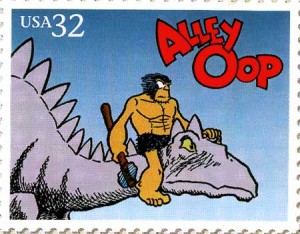
A 1995 stamp commemorated “Alley Oop” by Victor Hamlin, who once worked in oilfields at Yates, Texas.
Iraan (pronounced eye-rah-ann) began as a company town following the October 1926 discovery of the prolific Yates oilfield. The town’s name combined the names of Ira and Ann Yates. As petroleum drilling in the Permian Basin boomed, future Alley Oop cartoonist Hamlin worked as an oil company cartographer there. He developed a life-long interest in geology and paleontology that would lead to his popular Depression Era comic strip.
Learn more in Alley Oop’s Oil Roots.

August 7, 1953 – Outer Continental Shelf Lands Act generates Revenue
The Outer Continental Shelf Lands Act designated the Secretary of the Interior responsible for the administration of mineral exploration and development of America’s outer continental shelf. Forty-four Gulf of Mexico wells already were operating in 11 oilfields by 1949, according to the Bureau of Ocean Energy Management. As the offshore industry evolved in the 1950s, petroleum production became the second-largest revenue generator for the country, after income taxes.
August 7, 2004 – Death of a Famed “Hellfighter”
Famed oilfield well control expert and firefighter Paul “Red” Adair died at age 89 in Houston. The son of a blacksmith, Adair was born in 1915 in Houston. He served with a U.S. Army bomb disposal unit during World War II.

Famed oilfield firefighter Paul “Red” Adair of Houston, Texas, in 1964.
Adair had begun his oilfield career working for Myron Macy Kinley, who patented a technology for using charges of high explosives to snuff out well fires. Kinley, whose father had been an oil well shooter in California in the early 1900s, mentored many other firefighters, including Asger “Boots” Hansen and Edward “Coots” Mathews (Boots & Coots International Well Control).
After founding the Red Adair Company in 1959, Adair developed new techniques as his company put out more than 2,000 well fires worldwide — onshore and offshore. The oilfield firefighter’s skills, dramatized in the 1968 film “Hellfighters,” were tested in 1991 when Adair’s company extinguished 117 well fires set in Kuwait by Saddam Hussein’s retreating Iraqi army.
Learn more oil history and fighting tank fires in Oilfield Firefighting Technologies.
August 9, 1921 – Reflection Seismography reveals Geological Structure
A team led by University of Oklahoma geophysicist John C. Karcher conducted the world’s first reflection seismograph measurement of a geologic formation, pioneering the use of reflection seismic technology in petroleum exploration. Prof. Karcher’s seismography method would lead to discovery of many of the world’s largest oil and natural gas fields. The geological section measurement followed limited tests in June and July in Oklahoma City.
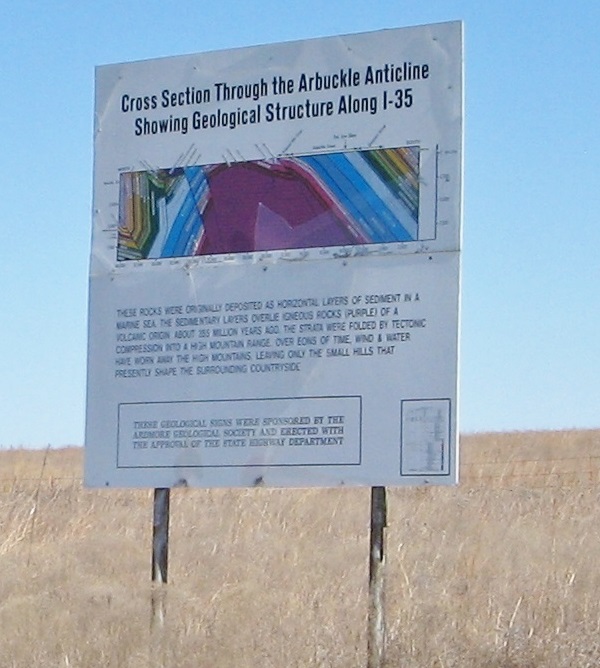
A roadside sign on I-35 south of Oklahoma City includes a geologic illustration of the Arbuckle Anticline, A nearby marker describes how using reflection seismograph for oil exploration began here. Photo by Bruce Wells.
The new geophysical method recorded reflected seismic waves as they traveled through the earth, helping to define oil-bearing formations. The Arbuckle Mountains of Oklahoma were selected for testing the technique and new equipment, according to a roadside marker at the site south of Oklahoma City on I-35.
Learn more in Exploring Seismic Waves.

August 9, 1922 – Major Oilfield found in Luling, Texas
After drilling six dry holes near Luling, Texas, the United North & South Oil Company completed its Rafael Rios No. 1 well. Company President Edgar B. Davis had been determined to find oil in the Austin chalk formation. His discovery revealed an oilfield 12 miles long and two miles wide. By 1924, the Luling field was annually producing 11 million barrels of oil.

In central Texas, the Luling Oil Museum is a restored 1885 mercantile store near an oilfield a renowned psychic supposedly helped locate in 1922.
Davis later sold his Luling leases to the Magnolia Petroleum Company for $12 million – the biggest oil deal in Texas at the time. Success also produced tales of Davis finding the giant oilfield only after consulting a psychic. The bogus oil patch reading came from self-proclaimed clairvoyant Edgar Cayce.
The once famous psychic claimed to have helped Davis and other wildcatters, but abandoned searching for Texas oilfields after forming his own company…and drilling expensive dry holes.
Learn more by visiting the Central Texas Oil Patch Museum in Luling.
On August 9, 1949 – Oil discovered in Western Nebraska
An oilfield discovery in western Nebraska ended decades of unsuccessful searching and helped start the state’s modern petroleum industry. Marathon Oil Company’s Mary Egging No. 1 well five miles southeast of the town of Gurley produced 225 barrels of oil per day from a depth of 4,429 feet.
According to a nearby historical marker, the first exploratory well drilled in the area near Harrisburg failed in 1917. The success in western Nebraska came nine years after the first Nebraska oil well was completed in 1940 in the southeastern corner of the state.

August 10, 1909 – Hughes patents Dual-Cone Roller Bit
“Fishtail” drill bits became obsolete after Howard Hughes Sr. of Houston, Texas, patented the dual-cone roller bit consisting of two rotating cones. By pulverizing hard rock, his bit led to faster and deeper rotary drilling.
Historians have noted that several men were trying to improve bit technologies at the time, but it was Hughes and business associate Walter Sharp who made it happen. Just months before receiving the 1909 drill patent, they established the Sharp-Hughes Tool Company to manufacture the new bit (see Carl Baker and Howard Hughes).

Howard Hughes Sr. of Houston, Texas, received a 1909 patent for “roller drills such as are used for drilling holes in earth and rock.”
“Instead of scraping the rock, as does the fishtail bit, the Hughes bit, with its two conical cutters, took a different engineering approach,” reported the American Society of Mechanical Engineers (ASME), which in 2009 designated the invention as an Historic Mechanical Engineering Landmark.
“By chipping, crushing, and powdering hard rock formations, the Hughes Two-Cone Drill Bit could reach vast amounts of oil in reservoirs thousands of feet below the surface,” ASME explained. “This new drilling technology would revolutionize the industry.”
Hughes engineers would invent the modern tri-cone bit in 1933, and Frank and George Christensen in 1941 developed the earliest diamond bit. The use of bits utilizing tungsten carbide arrived in the early 1950s.
Learn more in Making Hole – Drilling Technology.
August 11, 1891 – Oil Well brings prosperity to Sistersville, West Virginia
The discovery well of the Sistersville oilfield was drilled at the small West Virginian town on the Ohio River just north of Parkersburg. “The bringing in of the ‘Pole Cat’ well, which pumped water for a year before it pumped oil, brought in a sudden influx of oil men, drillers, leasers, speculators, followers, floaters, wildcatters, and hangers-on,” a local historian noted.
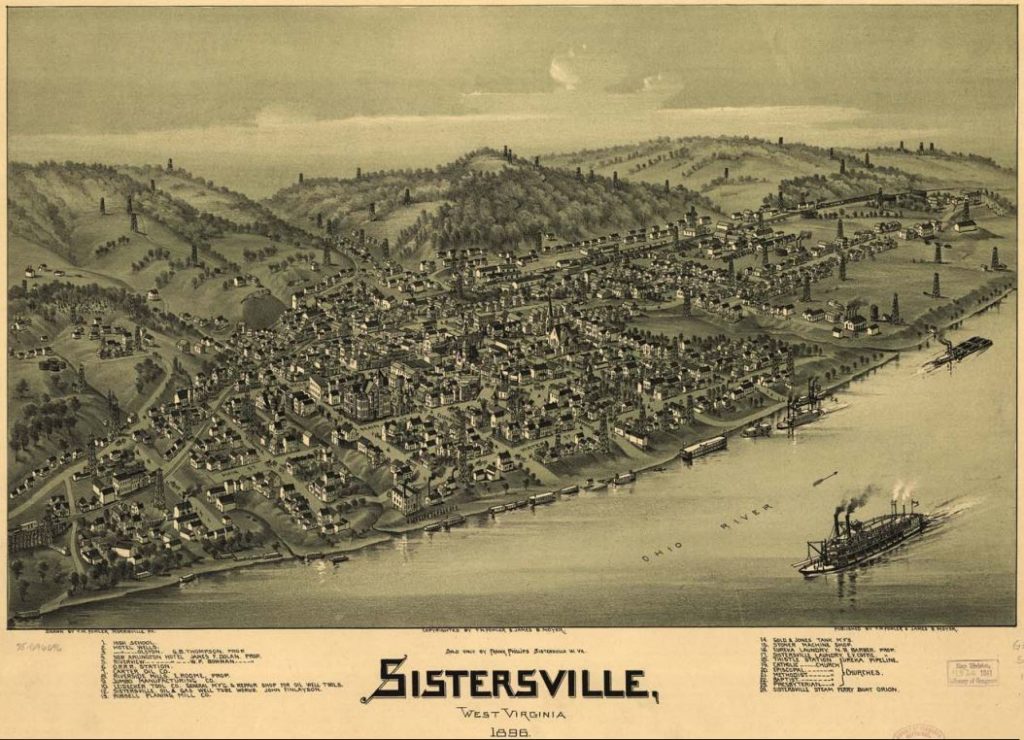
Bird’s-eye-view artist Thaddeus M. Fowler created maps of prospering towns and cities during the industrial revolution, including many oil boom towns like his 1896 lithograph of Sistersville, West Virginia. Map courtesy Library of Congress.
The petroleum wealth changed Sistersville from a rural village of 300 people, “to a rip-roaring” metropolis of 15,000 people almost overnight. At the height of its oil prosperity, Sistersville was featured among the popular maps created by artist Thaddeus M. Fowler of Massachusetts (see Oil Town “Aero Views”).
Today with a population of about 1,300, the Tyler County town proudly hosts an annual, three-day celebration of the 1891 Pole Cat well (later renamed the Sistersville well). According to longtime coordinator Barbara Vincent, the 55th annual Sistersville Oil and Gas Festival will take place for September 14-16, 2023.

August 11, 1998 – Amoco announces BP merger
Amoco announced plans to merge with British Petroleum in a stock swap valued at about $48 billion — then the world’s largest industrial merger. Amoco began in 1889 as John D. Rockefeller’s Standard Oil Company of Indiana. By 1985, the company had changed its name from Standard to Amoco.
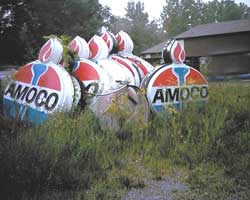
BP closed all of its Amoco stations in 2001.
Finalized on December 31, the combined company, BP Amoco PLC, became 60 percent owned by BP shareholders, marking the transaction as the largest foreign takeover of an American company. In 2001, BP announced Amoco stations would be closed or renamed to the BP brand.
August 12, 1888 – Bertha Benz makes World’s First Auto Road Trip
Thirty-nine-year-old Bertha Benz made history when she became the first person to make a long-distance trip by automobile. Her trip also included, “the first road repairs, the first automotive marketing stunt, the first case of a wife borrowing her husband’s car without asking, and the first violation of intercity highway laws in a motor vehicle,” noted a 2012 article in Wired.

Bertha Benz became the world’s first female automotive pioneer in 1888. Image courtesy Mercedes-Benz Museum.
Bertha drove away in the “Patent Motorwagen” (after leaving a note to her husband) and took their two young sons to visit her mother in Pforzheim. Their route from Mannheim was about 56 miles. The drive, which took about 15 hours, helped popularize Karl Benz’s latest invention.
By the end of the century, Mercedes-Benz was the largest car company in the world. The first road trip can today be retraced by following signs of the Bertha Benz Memorial Route. She was inducted into the Automotive Hall of Fame in 2016 as the first female automotive pioneer.
Learn more in First Car, First Road Trip.

August 12, 1930 – Kentucky Oil and Gas Producers unite
Eastern Kentucky independent producers joined the Western Kentucky Oil Men’s Association to create a state-wide organization in Frankfort — today’s Kentucky Oil and Gas Association (KOGA). A 1919 oil discovery in Hancock County had launched the petroleum industry in western Kentucky, where commercial amounts of oil had been found as early as 1829 near Burkesville while drilling for brine with a spring-pole (also see Kentucky’s Great American Well).
August 13, 1962 – Norman Rockwell illustrates Oil and Gas Journal
The Oil and Gas Journal promoted itself with an illustration from artist Norman Rockwell in an ad captioned, “Where Oil Men Invest Their Valuable Reading Time.” Rockwell’s renditions of American life brought him popularity through magazines like the Saturday Evening Post, Boy’s Life, and Leslie’s Illustrated Weekly.

A Norman Rockwell illustration advertised a leading industry trade magazine.
In addition to the illustrations for the Oil and Gas Journal, in 1959 Rockwell provided artwork to the American Petroleum Institute (API), which sponsored a U.S. Postal Service “first day of issue” commemorating the 1959 centennial of the birth of the U.S. oil industry (see Centennial Oil Stamp Issue).
The illustration included the slogan “Oil’s First Century 1859-1959, Born in Freedom Working for Progress.”
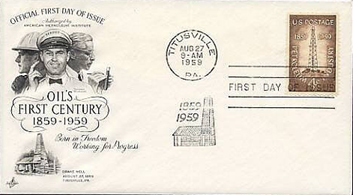
Norman Rockwell’s art commemorated the 1959 centennial of the birth of the nation’s oil industry.
Rockwell’s drawing depicted “the men of science, the rugged extraction of the crude oil, and ending with your friendly service station attendant,” according to a collector. Learn about another petroleum-related illustrator in Seuss I am, an Oilman.
_______________________
Recommended Reading: Yates: A family, A Company, and Some Cornfield Geology (2000); An American Hero: The Red Adair Story
(2000); An American Hero: The Red Adair Story (1990); Oil And Gas In Oklahoma: Petroleum Geology In Oklahoma
(1990); Oil And Gas In Oklahoma: Petroleum Geology In Oklahoma (2013); Texas Art and a Wildcatter’s Dream: Edgar B. Davis and the San Antonio Art League
(2013); Texas Art and a Wildcatter’s Dream: Edgar B. Davis and the San Antonio Art League (1998); Drilling Technology in Nontechnical Language
(1998); Drilling Technology in Nontechnical Language (2012); Bertha Takes a Drive: How the Benz Automobile Changed the World
(2012); Bertha Takes a Drive: How the Benz Automobile Changed the World (2017); The Birth of the Oil Industry (1938). Your Amazon purchase benefits the American Oil & Gas Historical Society. As an Amazon Associate, AOGHS earns a commission from qualifying purchases.
(2017); The Birth of the Oil Industry (1938). Your Amazon purchase benefits the American Oil & Gas Historical Society. As an Amazon Associate, AOGHS earns a commission from qualifying purchases.
_______________________
The American Oil & Gas Historical Society (AOGHS) preserves U.S. petroleum history. Become an annual AOGHS supporting member and help maintain this energy education website and expand historical research. For more information, contact bawells@aoghs.org. © 2023 Bruce A. Wells. All rights reserved.
by Bruce Wells | Jun 2, 2023 | Petroleum Pioneers
Drilling for water in 1894, Corsicana discovered an oilfield and became the richest town in Texas.
In the summer of 1894, town leaders of Corsicana, Texas, hired a contractor to drill a water well on 12th Street, but the driller found oil instead. The town’s oilfield discovery launched the first Texas oil boom seven years before a more famous gusher at Spindletop Hill, 230 miles southeast.
Corsicana’s first oil well produced less than three barrels of oil a day, but it quickly transformed the sleepy agricultural town into a petroleum and industrial center. The discovery launched industries, including service companies and manufacturers of the newly invented rotary drilling rig.
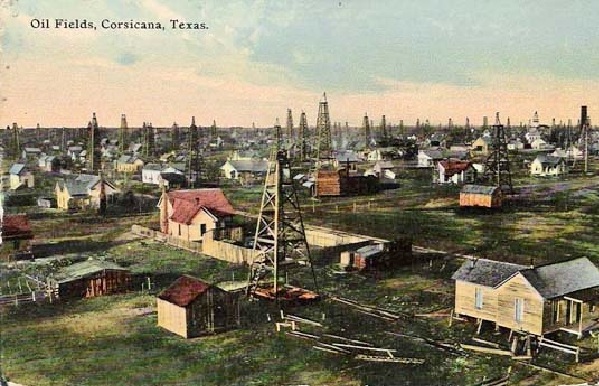
The first Texas oil boom arrived in the summer of 1894 when the Corsicana oilfield is discovered by a drilling contractor hired by the city to find water. Residents annually celebrate the 1894 discovery with a Derrick Day Chili & BBQ Cook-Off.
Corsicana local historians consider the 1894 discovery well, drilled on South 12th Street, the first significant commercial oil discovery west of the Mississippi (Kansans claim the same distinction for an 1892 Neodesha oil well).
The American Well and Prospecting Company (from Kansas) made the oil strike on June 9, 1894, at a depth of 1,035 feet. The city council — angry and still wanting water for its growing community 55 miles south of Dallas — paid only half of the drilling contractor’s $1,000 fee. (more…)
















